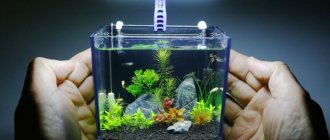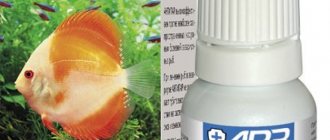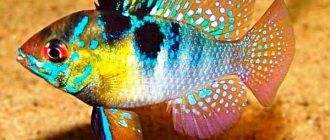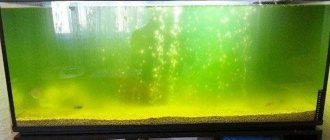The importance of the indicator for plants and other inhabitants
Fish are cold-blooded creatures, therefore, their body temperature will depend entirely on the temperature of the water in the aquarium.
When the optimal temperature level is maintained in the tank, the fish feel comfortable, do not get sick, and the metabolic processes in their body are not disrupted. When the water is too cold, internal processes begin to slow down (some species may even “hibernate”), and their immunity weakens; the fish become inactive and susceptible to any infection.
When the thermometer readings are high enough, metabolic processes are extremely accelerated, the fish become restless and begin to experience a lack of oxygen, which can lead to their death.
If the thermometer indicates an elevated temperature for a long time, this can lead to accelerated aging of fish and their premature death.
But the most detrimental effect on the inhabitants of the aquarium is temperature changes: a difference of 3 - 4 degrees can put the fish into a state of shock and, most likely, cause its death.
What should be the water temperature in a home aquarium?
In order for the inhabitants of home ponds to feel comfortable, the temperature there must be at a certain level. And before you introduce a fish into your aquarium, you need to know what the natural conditions of its existence are (and most aquarium inhabitants come from the tropics).
The gradation of temperature parameters can be represented as follows:
- the optimal aquarium temperature, which is suitable for most fish, is in the range from 220 to 260C;
- the water temperature in the aquarium below the minimum optimum is no longer acceptable for warm-water fish;
- An increase in temperature above 260 is permissible by 2-40C if it is gradual.
Changes in temperature in a home pond in one direction or another from the optimal parameters are more easily tolerated by aquarium inhabitants if the water is sufficiently enriched with oxygen. It will be most difficult for well-fed fish - they require more air no matter the temperature difference. But with sudden cooling, hungry fish will also suffer.
Optimal range
Before starting an aquarium, the owner needs to carefully study the peculiarities of keeping each type of fish whose presence is planned in the tank: the fish will feel good and live their intended life only if comfortable conditions are created for them.
Most often, the inhabitants of aquariums are heat-loving exotic fish from tropical and subtropical regions, where the water temperature in reservoirs throughout the year fluctuates between +24C - +30C.
Pisces native to South America, Asia, and Africa will feel comfortable precisely with these thermometer readings. And cold-water fish from northern latitudes prefer +21C . It is better to stock fish with similar temperature preferences in the same tank. But if this is not possible, then the optimal temperature suitable for all types is considered to be +24C - +26C.
Each species of fish has its own upper and lower threshold of maximum permissible temperature, exceeding which threatens their death.
Table of minimum, maximum and optimal temperatures
How many degrees should the temperature be in the aquarium? Let's look at the table:
| Name of the fish | Optimal temperature | Minimum temperature | Maximum temperature |
| Guppy | +23С – +27С | +18C | +30С |
| Neons | +20С – +22С | +18C | +28С |
| Angelfish | +22С – +26С | +18C | +28С – +30С |
| Cockerels | +26С – +30С | +18C | +36С |
| Discus | +29С – +32С | +28C and below | +34С – +35С |
| Barbs | +23С – +25С | +21С – +22С | +27С – +29С |
| Swordtails | +20С – +26С | +10С – +12С | +26С – +27С |
| Goldfish | +18С – +23С | +15C | +25С – +27С |
| Cichlids | +25С – +27С | +23C | +30С |
| Brochis | +22С – +26С | +18C | +30С |
Are the values different for a saltwater aquarium?
The temperature for marine aquariums does not differ from the temperature in freshwater aquariums : it should be within the range of + 24C - + 26C. Sudden changes in temperature also cause stress in fish and can trigger the development of diseases or cause death.
Thermometers
When kept in an aquarium, the water temperature requires careful monitoring. The possibility of sudden changes depends on the volume of the aquarium and the power of its heating or cooling devices.
Thermometers are used to measure the heat of a liquid. It is placed further from the heater, in the middle of the aquarium.
Thermometers come in 2 types depending on location:
- Outer. Attaches to the outer wall. Due to the location, the measurement results have a large error. Because the thermometer is also influenced by the air, which is often colder.
- Submersible (internal). It will be the best solution. Located inside the reservoir. The internal thermometer has a small measurement error and indicates a correct reading.
According to the type of action, thermometers are divided:
- Glass thermometer with mercury reading.
- Liquid crystal thermometer (self-adhesive strip on glass).
- Digital Thermometer.
- Alcohol thermometer.
Find out in advance what temperature should be in the fish aquarium.
Measurement
Since the life of living organisms depends on the temperature of the water in the aquarium, its measurement must be approached responsibly. The methods that are popular among the people, the elbow or the finger, are absolutely not suitable, and temperature measurement should only be entrusted to professional instruments.
Water heater
This is a device whose main purpose is to heat water to the required level, as well as maintain it within established limits.
Each water heater is equipped with a thermostat, thanks to which you can bring the water to the desired temperature as accurately as possible and, therefore, know its indicator.
Some models also have a temperature indicator that works even when the water heater is turned off.
Thermometer
Experienced aquarists use only a special thermometer to measure water temperature, which can be purchased at any pet store.
There are many different types of aquarium thermometers.
The most accurate is an electronic submersible or external electronic thermometer with a submersible sensor, the most popular is a glass thermometer, and the most attractive in appearance is a strip thermometer.
All thermometers can be divided into certain groups:
- Mercury thermometers (accurate, but their failure can lead to the death of all living things in the container).
- Liquid crystal (they are a strip with a printed scale that is glued to the outside of the aquarium; not accurate, but whimsical).
- Electronic (accurate, but quite expensive).
- Alcohol (not as accurate as electronic ones, but better than liquid crystal ones. They tend to wear out quickly and, therefore, lose accuracy).
Typically, thermometers are mounted in the middle layers of water on the opposite wall from the heater.
Temperature control methods
Having found out what temperature is comfortable for the fish species living in the aquarium, all that remains is to control it. Various devices are used as control devices:
- Glass coated thermometer. Provides accurate readings, is easy to use, and inexpensive. The only negative is that if the device breaks, toxic mercury will get into the water and the fish will be poisoned.
- Adhesive indicator strip. Easy to use, simply sticks to the surface of the tank. The downside is the lack of accuracy of the indicators.
- Thermometer with alcohol filler. Convenient and inexpensive option. But gradually the reliability of the indicators decreases.
- Electronic thermometer. Provides the most accurate indicators. But it's expensive.
How to keep the indicator normal?
The ideal option is to equip the aquarium with a water heater that automatically turns on for heating and automatically turns off when the set threshold is reached. As mentioned above, this device is capable of not only bringing the water temperature to the optimal level, but also maintaining it at this level.
To avoid temperature fluctuations, the location for installing the tank should be carefully thought out: it should be away from heating appliances, air conditioners, away from direct sunlight and drafts.
Adviсe
- Place the container in the right place, away from windows, radiators and air conditioners.
- Buy a heating pad.
- Equip the tank with a thermometer.
- Don't forget about aeration.
- Use alcohol only in extreme cases.
- The safest way is to lower the bottle with hot/cold liquid.
With careful attention to your pets and careful care, the parameters of the fish will always be at the optimal level. This will protect the inhabitants from most diseases. Pay attention to this!
Next
Aquarium Do-it-yourself aquarium stones: which ones can be used, processing, problems
Great article 0
How to raise the temperature?
- Find out the reason for the temperature drop: close an open window, replace a broken water heater.
- If replacing the heating device is not possible, then you can lower a plastic bottle filled with warm water into the aquarium.
- As an option: move the container closer to the heat source, for example, a battery. Or lean a heating pad with warm water against the wall of the tank.
- You can immerse the external filter in a vessel with warm, but not hot water.
- An emergency measure to “revive” frozen fish is to add cognac or vodka to the water (30 ml per 100 l). After a day, the water may become cloudy, which can be prevented by replacing a third of the water or filtering it through activated carbon.
Ways to maintain temperature
To maintain comfortable living conditions and parameters, you will need devices that are sold in pet stores or available at home.
Methods for heating the tank:
- Using a special heater.
- Using a hot water heating pad.
Tank cooling methods:
- Buying an aquarium refrigerator.
- Turn on the fan.
- Maintaining the required parameters with an air conditioner.
- Using ice cubes.
Each aquarist decides for himself how to maintain the optimal temperature for the aquarium. By using heaters and refrigerators, the aquarist will achieve complete control over the thermometer readings, but this will be expensive. It will be cheaper to use heating pads and ice, but if you make a mistake this will cause harm to the inhabitants.
How to help with deviations
Sometimes the aquarist neglects to monitor the thermometer or the heating or cooling equipment breaks down. Do not underestimate the effect of water temperature on the inhabitants of the tank. It is important to quickly take action to return indicators to acceptable limits.
Overheat
If the thermometer reading is above 30 degrees, then the inhabitants have a high probability of dying.
If there is excessive heating, the main thing is to lower the temperature in the reservoir.
Reasons why the environment becomes very warm:
- Direct sunlight.
- High ambient temperature.
- Excessive proximity to heating devices.
- Close proximity to a powerful lamp.
- Incorrect reading from the water temperature control station for aquarium fish.
- Lack of cover.
How to quickly cool water in a tank:
- Pour cold liquid into a bottle and lower it into a superheated tank.
- Point a fan at the surface of the liquid
- Use an aquarium cooler or refrigerator.
- Add ice to the water.
A dangerous consequence of an increase in thermometer readings is a lack of oxygen in the water. Pets will experience a lack of oxygen. The inhabitants swim up and try to breathe air from the surface. To saturate the liquid with oxygen, the liquid must be constantly aerated. To sharply increase the amount of oxygen, compressors, hydrogen peroxide and oxygen tablets are used. After a while, the fish will breathe calmly.
Hypothermia
When the room is ventilated and there are drafts, the temperature quickly drops.
To heat the liquid and maintain optimal performance, the following methods are used:
- Using a heating pad.
- Pour boiling water into the bottle and place it in chilled water.
- Add boiled water from the kettle. Be careful when pouring boiling water. The percentage of boiled liquid should be below 10.
- Use an aquarium heater.
- Replace some of the water with warmer water. But this should be done slowly, and do not increase the degrees sharply.
- Bring a powerful lamp to the surface.
- Blow hot air onto the surface of the liquid.
- Use a low boiler.
- Catch and place the fish in an aquarium with warm water (if you have one).
- Use alcohol if other methods are not suitable. Add 1 tablespoon per 100 liter tank. Don't forget to change the water afterwards.
Sudden changes
If fish are able to survive a low or high thermometer without any problems, then sudden changes will certainly cause illness. Pisces are sensitive to changes. The range of fluctuations of the thermometer should not be large in a short time. It often happens that when transporting fish it fluctuates greatly. In this case, many inhabitants will not arrive alive.
How to reduce it in summer and other times of the year?
Determine the reasons for the temperature increase (for example, the location of the battery), eliminate them.- Place a plastic bottle of cool water into the container (in the first 10 minutes a decrease of 2 degrees is possible, in the next 20 minutes - minus two degrees).
- Increase aeration in the aquarium: the compressor should run until the temperature can be reduced.
- To enrich the water with oxygen, you need to stir it with your hand or pour in 3% hydrogen peroxide (20 - 25 ml per 100 liters).
Video about lowering the temperature in an aquarium:
Temperature table for each type of fish
The correct temperature in the aquarium is one of the most significant factors ensuring a long and comfortable life for fish. For owners involved in arranging a tank, a table is provided that indicates the preferred water parameters for the most common types of aquarium inhabitants.
| fish species | average temperature range, °C | maximum and minimum permissible temperature, °C |
| angelfish | 24 – 27 (the higher the temperature, the faster the individuals grow and reproduce better, but life expectancy is reduced) | 19 – 30 |
| guppy | 23 – 26 (in cool water the fish becomes larger, but loses immunity) | 15 – 30 |
| swordtails | 23 – 25 | |
| neons | 22 – 25 | 17 – 29 (with extreme parameters, the life expectancy of individuals becomes shorter) |
| Siamese cockerels | 24 – 28 | |
| gourami | 22 – 26 | 20 – 30 (fish do not live long at the maximum parameters) |
| mollies | 25 – 27 | |
| zebrafish | 21 – 25 | |
| parrots and other cichlids | 24 – 30 (the higher the temperature, the richer the color) | adult individuals are able to withstand extreme increases and decreases in temperature for up to 6 hours |
| goldfish | 20 – 24 | |
| barbs | 20 – 27 | |
| somas (pterygoplichthys, agamyxis, bunocephalians, synodontis) | 24 – 27 | |
| red-eared turtles | 24 – 29 |
Video on the topic
Watch a video about the importance of water temperature in an aquarium:
The life of all living things in the aquarium directly depends on the water temperature. The issue of constant monitoring of temperature indicators should be approached as responsibly as possible.
- Related Posts
- Why does the life of fish depend on the preparation of water in an aquarium and how to do everything correctly?
- Aquarium care: how to change the water and what to do with fish and plants?
- What is water aeration in an aquarium and why is it needed?
Quality checking
The reason for poor health of fish and slow growth of plants is poor water quality. It is impossible to identify the problem by eye; the content of impurities is checked using tests or instruments.
Tests offered by pet stores are a proven (and quick) way to monitor water quality. They are special indicators that record the degree of concentration of a chemical substance.
It is important to understand that:
Diagnostics are not needed if the inhabitants of the aquarium feel well. Tests are needed in a new aquarium where the ecosystem is not yet established. Testing is also necessary for those who regularly use fertilizers (to avoid overdose).- There are tests separately for fresh or sea water, as well as universal ones.
- Drop tests provide reliable results. Test strips are less accurate, but they are good at diagnosing a problem.
- If there are problems with fish, first of all they test for acidity, ammonia, nitrates, nitrites.
- An aquarium with plants is additionally tested for phosphate, total and carbonate hardness.
- Periodic testing for metal impurities (copper, iron) is useful.
Reference! Tests can be purchased individually or in the form of kits, which is much more profitable. For diagnostics, it is convenient to use special instruments (for example, a chlorometer for determining chlorine), but purchasing a “collection” of meters is only advisable for owners of several aquariums.
A complete overview of aquarium tests can be found here.
Practical tips for using aquarium tests in the video:
Types of aquarium water heaters
Here are the most popular types of heaters
Adjustable internal heater
This is the simplest water heater, consisting of a body filled with filler, a glass tube or thin stainless metal. The heating element in them is soldered into the housing without the possibility of replacement. The heater has a number of significant disadvantages. In the case of a glass tube, it is fragile. And it can break or crack if it overheats - if for some reason it ends up above the water level.
The device, which combines a thermostat and a heater, can regulate the water temperature by interrupting the power circuit using a bimetallic strip. It is best to install the heater horizontally or at a slight angle near the surface of the water. This will help avoid premature shutdown of the device.
Electronic thermostat
A type of heater of any shape and size, made in a plastic case. This allows you to install it anywhere in the aquarium. The microprocessor control element allows you to set the operating modes of the device. Allowing you to change the temperature throughout the day. This heater does not break and has protection against overheating.
Heating element - without the ability to adjust the temperature. This heater will consistently deliver 2-2.5°C to water throughout the entire operating time without overheating. The safety of the water heater is achieved thanks to the “RTS-film” system. Which will turn off the device in case of any violation of its operation. The heating plate is suitable for all types of aquariums. And it can even be located in the ground at its bottom.
Heating cable
Heating device of high heat transfer in the form of a cable. Which contains an alloy with high resistance characteristics inside and a heat-resistant shell on the outside. This heater is flexible and can be placed into any shape. The heating cable cannot be used without an external thermostat.
Heating mat
A heating element in the form of a mat that should be placed directly under the aquarium. This mat transfers heat through the glass and bottom of the aquarium directly into the water. It is used to heat the bottom layers of soil for better plant growth and the comfort of fish living on the bottom. Heat dissipation into the water column occurs slowly. But with constant operation, such a device can heat the entire aquarium. A heating mat has a significant drawback - a lot of heat is wasted for other purposes. For example, to heat the aquarium cabinet on which it is located.
External flow thermostat
A heating device installed behind an external filter and using already filtered water for heating. This type of heating device is high-performance and is only used in very large aquariums. Its minimum power is 200 W. The heater has its own thermostat and control and automation unit. Displayed in a convenient place for the user. Such devices are very reliable and undemanding to maintain.
Filter with water heating function (thermal filter)
A combined device that provides in-line heating of water leaving the filter cartridge. It has its own thermostat and programmer with the ability to adjust the temperature. A convenient device that allows you to get by with one external or internal filter without the need to mask a separate heater in the aquarium. This is a good solution for small aquariums. The disadvantage of such a heater and filter at the same time is the possibility of breaking everything at once. Although it is reliable, it is better to use two different devices.
Based on the size of the aquarium, you need to make the right choice of the required heating device. Depending on the needs of the inhabitants of your artificial reservoir.
A necessary condition for the operation of any water heater is the quality of its manufacture. After all, this is an electrical appliance with all the ensuing consequences of its use in water. The only thing you can influence when installing a heater is to make sure that the wire running from it to the outlet in a certain place sag and does not bend. The sagging of the wire is a necessary measure to prevent drops of water from entering the outlet through it and subsequently shorting it.











